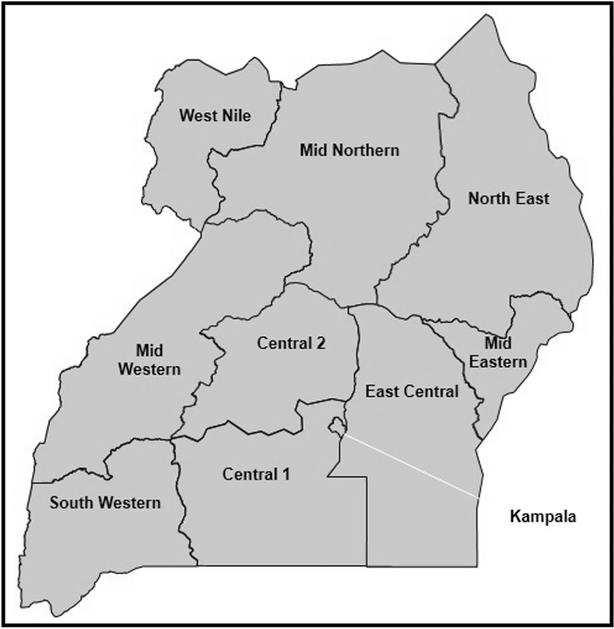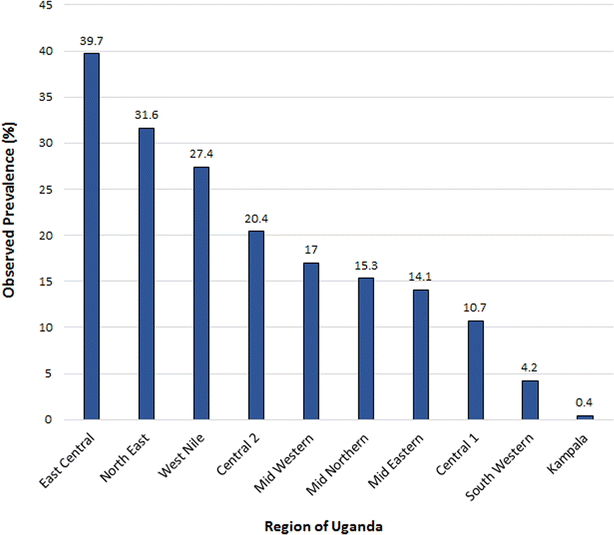Risk factors of malaria in children under the age of five years old in Uganda
- PMID: 27121122
- PMCID: PMC4848810
- DOI: 10.1186/s12936-016-1290-x
Risk factors of malaria in children under the age of five years old in Uganda
Abstract
Background: Malaria is the leading cause of morbidity in Uganda with 90-95 % of the population at risk and it contributing to approximately 13 % of under-five mortality. The aim of this study was to investigate the relationship between the malaria status of children under the age of 5 years old in Uganda and selected socio-economic, demographic and environmental factors, as well as to identify significant risk factors associated with malaria.
Methods: This study made use of data collected from the 2014 Malaria Indicator Survey conducted in Uganda. Two test procedures for malaria in children under the age of 5 years old were carried out. Due to the complex survey design, a generalized linear mixed model was used to test for associations between several independent variables and the response variable, which was whether a child tested positive or negative for malaria according to the microscopy test.
Results: The sample in this study was made up of 4939 children. Of those children, 974 tested positive for malaria, resulting in an observed malaria prevalence of 19.7 %. The socio-economic factors closely related to the risk of malaria were main floor material, main wall material and availability of electricity in the household. The event of indoor residual spraying (IRS) significantly reduced a child's risk of malaria. An older child was associated with a higher risk of malaria, however their risk decreased with an increase in cluster altitude and an increase in their caregiver's education level.
Conclusion: Although there has been a significant increase in the use of mosquito nets since the previous Malaria Indicator Survey done in 2009, particularly in the use of insecticide-treated nets (ITNs) and long-lasting insecticidal nets (LLINs), these control measures alone may not be sufficient. IRS will be a key strategy in reaching the malaria goals set by the government of Uganda. Supplementing these control measures with education of appropriate and consistent use of ITNs and LLINs, as well as education of practicing safe living habits, such as reducing outdoor activities during peak biting hours of a mosquito, can go a long way in aiding the reduction of the burden of malaria in Uganda.
Keywords: Complex survey design; Generalized linear mixed model; IRS; ITNs; LLINs; Microscopy test.
Figures
References
-
- WHO . World malaria report. Geneva: World Health Organization; 2015.
-
- Uganda Bureau of Statistics (UBOS) and ICF International. Uganda malaria indicator survey report; 2014–15. Kampala and Rockville: UBOS and ICF International.
-
- National Institute of Allergy and Infectious Diseases. Understanding malaria. NIH Publication; 2007. (07–7139).
-
- WHO and UN Partners. Country statistics and global health estimates. Uganda: WHO statistical profile; 2015.
-
- CDC. Global health—Division of Parasitic Diseases and Malaria; 2012. http://www.cdc.gov/malaria/malaria_worldwide/reduction/index.html. Accessed 23 Jul 2013
Publication types
MeSH terms
LinkOut - more resources
Full Text Sources
Other Literature Sources
Medical



